Sleeping on a bed that isn’t rocking me to sleep was a dreadful inconvenience last night! I don’t know what I am going to cope once I get home. Like, actual home, home… not home to our beautiful Sea Princess in a few nights time. 🙂
We have a big day of planes, trains and automobiles in front of us so we started off the day with a lovely buffet breakfast at the Costa del Sol, comprising of fruits, eggs, crepes and whatever you wanted really. The odd addition of cacao tea for people heading to places of elevation was welcome and while I have no idea of its actual efficacy, if even a placebo benefit was to be had, I was going to try it. I’ve had elevation sickness before and while not terribly debilitating to me personally, it isn’t pleasant – headaches, nausea, and if it gets bad, nose bleeds. The tea itself was like a mild green tea, but rather flavourless; but nothing ventured, nothing gained.
We made our way all the way back to the airport, – the entire arduous 120m journey that it was. Seriously, it was so good to be right there! And checked out luggage and went through security. Now Jaime had told us that Lima airport on a Monday morning was always, always a nightmare of work commuters, but today we found ourselves whipping through check-in and breezing through security and instead of standing in queues for a couple of hours as expected, we were in and then slothing around the boarding gates and checking out the airport shopping with heaps of time before our flight.
We ran into several Princess friends, while buying cacao chewing gum at the newsagent, who were also heading to Machu Picchu, but who were travelling on one of the ship’s tour buses – they told us they had been up since sparrows fart because they had a one hour drive to get from their hotel back to the airport, and had also catered for the fact that Monday mornings at Lima airport are traditionally madhouse. When I told one of them that we had got up and simply walked across the street from the Wyndham, she was positively jealous!
Our flight was fine, I sat with two local ladies I think, and unfortunately was allocated the aisle seat – when we came in to land in Cuzco, I was desperately straining to see the mountains out the window, while the lady who had the coveted window seat was busy playing solitaire on her iPad. Le sigh… Oh well, thems the breaks.
On our arrival we were met by our local guide, Luiz who, (instead silent squee! here…) is a qualified archaeologist with a speciality in Inca history! I was thrilled to hear we were going to be guided through one of the worlds most important ancient sites by someone with a real passion for this amazing place. First things first though, it had been a long flight and we were now in Cusco, and at 3.300 m (11,200 ft), I was immediately feeling the effects of the altitude. Not in the form of any elevation sickness symptoms, but most definitely a heaviness on my chest that made breathing feel a bit difficult. The cacao gum may or may not have helped with other symptoms but nothing was going to change the fact that I live at sea level, have spent the last two months on a ship and was now sucking in thinner oxygen than I’m accustomed to. Thankfully, my overly cautious GP had packed me off with a Bricanyl inhaler, which is a bronchial dilator, for just this purpose because I had a bad bout of pneumonia last winter. One puff on that and I felt like I was breathing as easily as I do at sea level… being perpetually pessimistic and therefore prepared for nearly any eventuality, really does have its advantages sometimes.
Cusco is a city in southeastern Peru with a population of around 400,000 people; I don’t know why I was expecting a quaint little mountain town really, but I was. It is the historical capital city of the Inka Empire which was arguable from the 13th to 16th centuries (arguably, because historians are aware of the Kilke people who lived in the region for thousands of years before this, but through 1200 -1500AD, they had an increasingly empirical structure). 
We took a quick drive through downtown Cusco on our way to our lunch stop which was at a farm/colonial hacienda outside of town. Cusco is a really beautiful town with red Spanish style tiled roofs everywhere. This waterfall is located at the Y intersection of two of Cusco’s main streets – the rondel in the centre represents the sun, the Inka people worshipped the Sun God, much like the people of Egypt and their worship of Ra. The two water falls joining into one large waterfall is a depiction of the two rivers that now run under the two main streets of Cusco and join at this site.
 Pachacuti was the 9th Inka King who, according to legend, transformed the Kingdom of Cusco from a quiet city-state into a vast empire called Tawantinsuyu (yeah, no matter how hard I try, I can’t pronounce that one). However, archaeologists feel the evidence shows a slower more organic growth of the city that started well before Pachacuti. This occurred due to a tradition of split inheritance – when an Inca died, his title would go to his son, but his property and his wealth would transfer to all his relatives, which would then compel each relative to go find new lands to build their own house and as such the empire grew. In 1533, the Spanish conquest occurred and by all accounts, the Spanish seized control over thousands of Inka people fairly easily due to their cavalry, armaments and superior military technology; heralding in the city’s colonial period.
Pachacuti was the 9th Inka King who, according to legend, transformed the Kingdom of Cusco from a quiet city-state into a vast empire called Tawantinsuyu (yeah, no matter how hard I try, I can’t pronounce that one). However, archaeologists feel the evidence shows a slower more organic growth of the city that started well before Pachacuti. This occurred due to a tradition of split inheritance – when an Inca died, his title would go to his son, but his property and his wealth would transfer to all his relatives, which would then compel each relative to go find new lands to build their own house and as such the empire grew. In 1533, the Spanish conquest occurred and by all accounts, the Spanish seized control over thousands of Inka people fairly easily due to their cavalry, armaments and superior military technology; heralding in the city’s colonial period.
Our first stop was a lookout at the We went first to the Christo Blanco – the White Christ, which is placed at an amazing high vantage point that gives fabulous views of the city… and then it was on to lunch.

 The lunch venue that greeted us was an unexpected delight… a beautiful old building with a lovely history, and a passion for local food.
The lunch venue that greeted us was an unexpected delight… a beautiful old building with a lovely history, and a passion for local food. 


 We were greeted by our hostess, Ana Maria Milla Hurbado (what a fabulous name!) and all all welcomed like old friends and made very comfortable. The room was amazingly beautiful and lovingly presented, and then, oh my goodness, then Ana went through the buffet and explained the dishes we would be sampling. Ana, as it turns out was born in Peru, but had spent a year as an exchange student in a small town in Kansas, so she had excellent English which she put to good use, sharing her passion for Peru’s traditional foods. Ana has researched and studied the food of the region dating back nearly 14,000 years and our menu today reflected much of the rich cultural heritage of the area.
We were greeted by our hostess, Ana Maria Milla Hurbado (what a fabulous name!) and all all welcomed like old friends and made very comfortable. The room was amazingly beautiful and lovingly presented, and then, oh my goodness, then Ana went through the buffet and explained the dishes we would be sampling. Ana, as it turns out was born in Peru, but had spent a year as an exchange student in a small town in Kansas, so she had excellent English which she put to good use, sharing her passion for Peru’s traditional foods. Ana has researched and studied the food of the region dating back nearly 14,000 years and our menu today reflected much of the rich cultural heritage of the area.
I had a good long talk with Ana after lunch about the various dishes and she was very obliging in writing some of them down… There was Lomo Salgado – a beef dish with tomatoes, onions, yellow peppers, wine, vinegar, soy, french fries and parsley. This is the sort of dish that everyone knows how to cook in Peru, and if you ask, everyone will tell you that their own mother makes the best Lomo Salgado. It was fantastic.
We also had Yuca balls – made from mashed potatoes, stuffed with cheese and deep friend then served with a cheesy, slightly chili sauce. Warm corn salad – made from a local variety of giant white corn, tomatoes, peas, mushrooms, cheese and olive oil.
Causa Limena – which was a truly unusual layered dish. Mashed yellow potatoes made with puréed yellow peppers and lime juice, then layered with tuna mixed with mayonnaise and layers of avocado, and all presented looking like a lovely cake.
 We also had one of 3000 species of potatoes – which out which Ana tells us the global population would be down 200 million on its current levels, served with a spicy smooth salsa verde sauce that was to die for, just the right amount of bite to it.
We also had one of 3000 species of potatoes – which out which Ana tells us the global population would be down 200 million on its current levels, served with a spicy smooth salsa verde sauce that was to die for, just the right amount of bite to it.
There was also had pasta with a rich bechamel sauce, a traditional rice dish, a chicken and current scroll dish, and my favourite, the Camote – which are sweet potato chips served with a mango and ginger sauce. This is a real local dish as well, but also with a bit of tradition about it – people in the region use the word ‘camote’ for anything connected to crazy beautiful love, that in the first flushes of romance sort of thing. So they would say, ‘Aaah, you have camote for Juan Guillermo’ or, ‘He is totally camote for her’, but it has nothing to do with sweet potatoes!
All up, it made for a very colourful lunch, and I tried to have a tiny bit of each unusual dish… Juice made from the purple corn:
Juice made from the purple corn:

Ana and her team of cooks have a real passion for what they do and it was obvious to all. We had one of the most enjoyable meals I’ve had in a long time – and this coming from someone who has just spent the last two months being catered to on a cruise ship!
www.laprincesitaeventos.com if anyone is interested.
After lunch we had a quick look around the lovely kitchen gardens attached to the hacienda and then it was off to investigate the area surround Cusco.




We did a bit of a fly by photo stop to see some Inka ruins at the Saqsayhuaman National Park. And I was a little disappointed not to be able to go in and explore somewhat, but we were on a schedule and I was assured there would be plenty of Inka ruins in store for us. Our bus ride took us through some amazing countryside through the towns of Saqsayhuaman, Qenqo, Pukapukara and Tambomachay as we traversed the Andes mountain range above the Cusco Valley.

 This pass marks the highest point that we were going to be travelling through, and also the highest point on the traditional Inka Trail. At 3,700m the air was pretty thin here, and some of us were getting a bit headachy at this point. Amazing views over the Sacred Valley… so called because it aligns under the Milky Way. The Inka people were very in tune with astronomy and nature.
This pass marks the highest point that we were going to be travelling through, and also the highest point on the traditional Inka Trail. At 3,700m the air was pretty thin here, and some of us were getting a bit headachy at this point. Amazing views over the Sacred Valley… so called because it aligns under the Milky Way. The Inka people were very in tune with astronomy and nature. 


In spite of our hectic schedule, we drove a little further into the Sacred Valley and did get an opportunity to quickly visit the fabulous little town of Pisaq, and a chance to shop in the famous Pisaq markets. Pisaq too, has some amazing archeological remains surrounding the city in the mountains, and is a very beautiful town… lots of tiny winding streets which our bus driver skilfully navigated – and I mean skillfully… there was bare inches between nearly every corner of our 30 seater bus and brick buildings at some points!

First thing we were greeted by when we arrived at the markets were some children dressed in colourful traditional Peruvian outfits, and carrying baby llamas, inviting us to take their photograph; their mother looking on from nearby. They looked adorable and of course many of us pulled out our cameras and gave the children some money – this is a common thing in South America… we saw it with the ladies in Cartagena with the colourful clothing and the fruit bowls on their heads and we have seen it other places too. However, while I think it is nice for the tourists to be able to have an opportunity of seeing some locals in their native dress, it also concerns because these children are effectively being pressed into begging by their parents to make money off the tourists. Both of these kids were school aged and obviously not in school in spite of it being a regular Monday afternoon.


The markets themselves were so much fun! We were given barely 45 minutes, as we had a train to catch, to go speed haggling! The markets were full of beautiful textiles: blankets, jumpers, shawls, ponchos, pashminas, tablet woven bands, table cloths – you name it. As well as ceramics, paintings, wood work, jewellery, stone carvings and all of it in a multitude of rainbow colours. We found some gorgeous alpaca shawls and of course had to buy several, with limited time to haggle, we found the best deals were to be had by buying in bulk. 😛 Sound familiar Dr Nick?! 😀
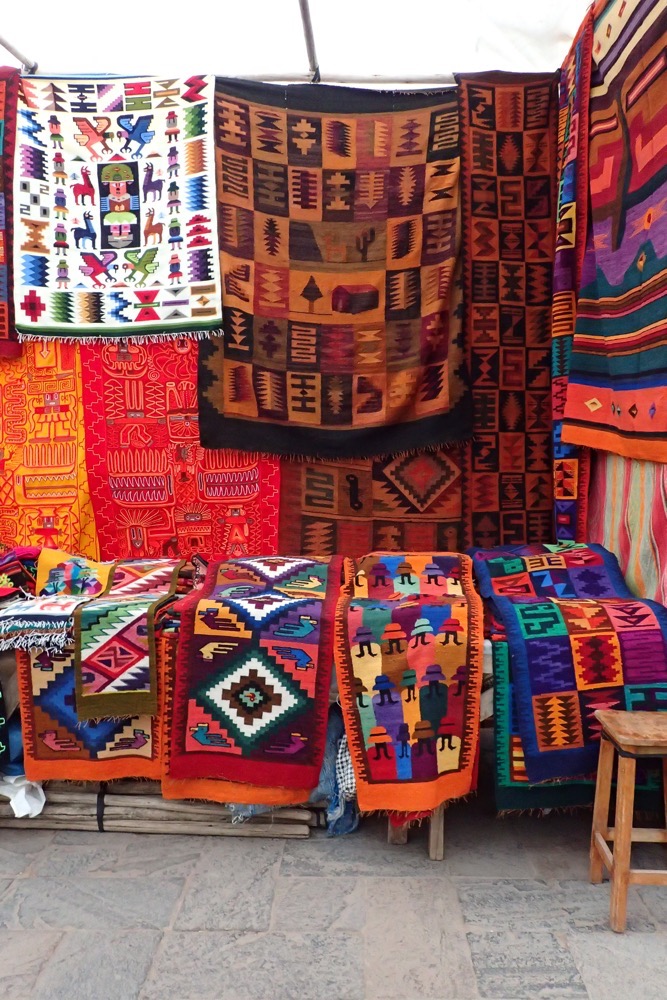


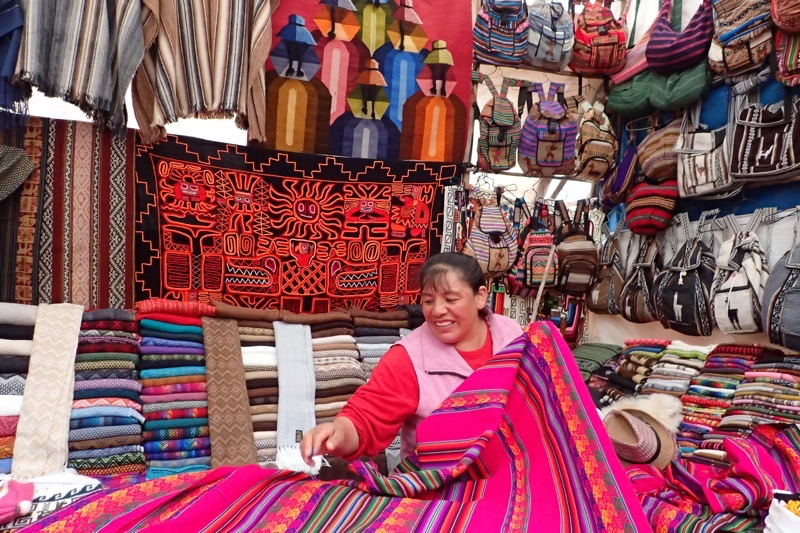
 Tablet weaving…
Tablet weaving…

After our visit to the markets, it was back on the bus and driving through the villages of Lamar, Coya, Calca and Urumbama doing some speed landscape photography, before getting to Ollantaytambo, where all the trains leave from to Aguas Calientes – the town at the base of Machu Picchu National Park, where we would be staying for the night at the El Mapi Inkaterra Hotel.


 Not far from the train station in Ollantaytambo, we saw the hotel where our Princess friends on the Princess Machu Picchu Overland shore tour were staying – we had a train booked for 18:30 that would get us to Aguas Callientes by about 20:30, in time for a rather late dinner, but the ship tour stays in Ollantaytambo, and they don’t take the train to Aguas Callientes until mid-morning for some reason. Not sure why…? We walked to the train in a light rain on precariously narrow footpaths and plenty of traffic, only to then find ourselves walking on the train track to get to the right train. It was very hectic!
Not far from the train station in Ollantaytambo, we saw the hotel where our Princess friends on the Princess Machu Picchu Overland shore tour were staying – we had a train booked for 18:30 that would get us to Aguas Callientes by about 20:30, in time for a rather late dinner, but the ship tour stays in Ollantaytambo, and they don’t take the train to Aguas Callientes until mid-morning for some reason. Not sure why…? We walked to the train in a light rain on precariously narrow footpaths and plenty of traffic, only to then find ourselves walking on the train track to get to the right train. It was very hectic!

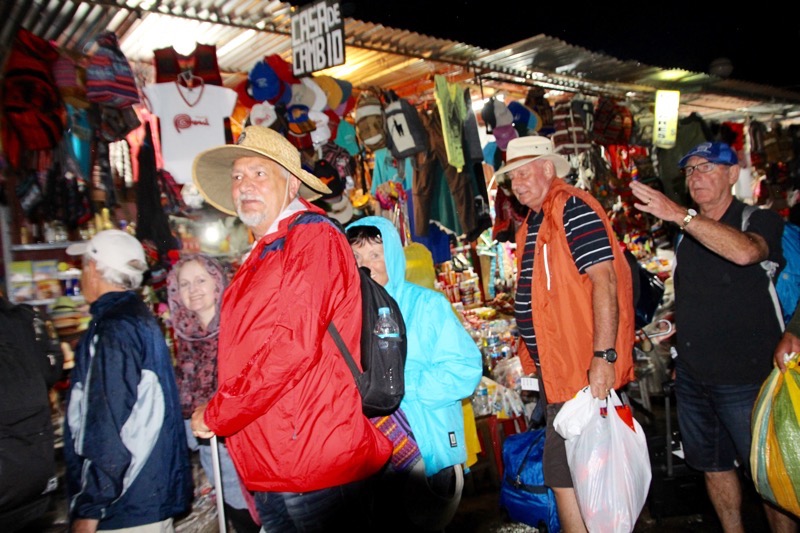


The train trip went okay, we were all feeling the full on, ‘planes, trains and automobiles’ theme of the day by this point, but were buoyed by the expectation of the adventure to come tomorrow. The trains are all fitted out with glass domed roofs, but given our train ride was at night – there was not much to see. Our view on the way back was promising to be more interesting. We arrived to Aguas Callentes amid a real buzz that felt like complete organised chaos! It was raining a little, dark, and there were hundreds of people alighting from the train, collecting their luggage and then trying to find their way to their hotels. The town itself has no transport within it – it is pretty much a pedestrian town with a huge set of rapids running through the middle of it, and a train station. We all marched like ducklings following Jaime to the El Mapi Inkaterra hotel, where we had a speedy check-in process in what turned out to be a lovely modern hotel…
 … and then it seemed barely minutes after arriving, we were sitting in a lovely terrace restaurant and being served a gourmet meal, with a free pisco sour and (very importantly) free wifi! 😉 Delicious soups, quinoa tabbouleh, lamb shanks and lemon pie for dessert. In spite of having had a simply delicious buffet lunch, most of us enjoyed a lovely dinner as well.
… and then it seemed barely minutes after arriving, we were sitting in a lovely terrace restaurant and being served a gourmet meal, with a free pisco sour and (very importantly) free wifi! 😉 Delicious soups, quinoa tabbouleh, lamb shanks and lemon pie for dessert. In spite of having had a simply delicious buffet lunch, most of us enjoyed a lovely dinner as well.




By the time dinner was over, the rain had stopped and a few of us went for a wander around the wee village. Everything looked like it had been washed clean, and while many of the shops were closed, the restaurants and bars were mostly all still open. The town is a crazy blend of cultures and influences and it is like no where I have ever been. Cute little cobbled laneways off the two main streets, and a square in front of a large church. I was very much looking forward to exploring more here tomorrow.
Pachacuti welcomes you to Aguas Callientes and the gateway to Machu Picchu… it was about this point, that I was in disbelief that we were actually here.



There were a couple of people in our group who were starting to feel the effects of the altitude during the day – one friend ended up being sick on the way to the train, and a couple of others were having some issues with breathing, but seemed to be revived with a bit of oxygen. So far, I hadn’t had any problems – I had been drinking the cacao tea, chewing my cacao gum, and had a second dose of Bricanyl before bed, which seemed to be enough to keep me on an even keel. I had a bad headache, but honestly couldn’t tell you if that was from the elevation or from my crappy neck/back being jostled around on buses all day?! So it was an early night all round – we had alarms and wake up calls all sent for 06:00, so we could have time for breakfast and checking out in order to catch a bus up to Machu Picchu for 07:30!



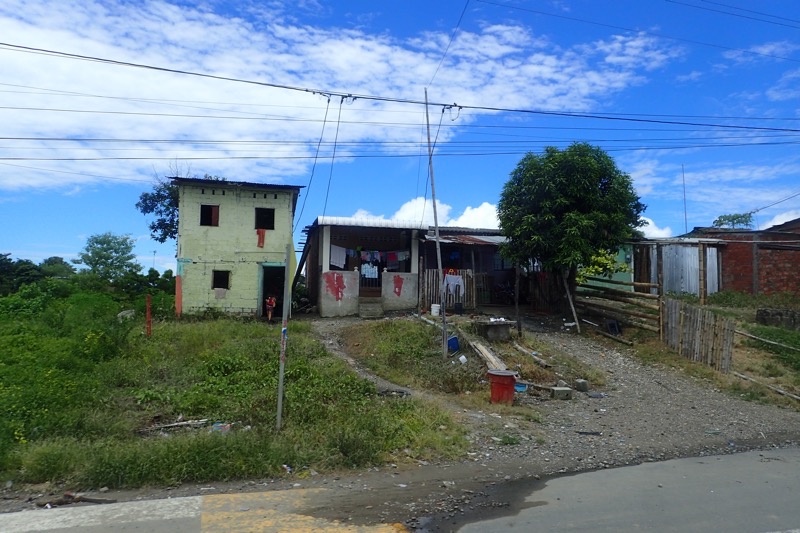
 The saint of Guayaquil, who isn’t actually from Guayaquil and whose name I’ve forgotten… whoops. (Maybe I’ll come back and fix that if I ever return to the land of decent internet). Her name is Narcisa de Jesús Martillo y Moran.
The saint of Guayaquil, who isn’t actually from Guayaquil and whose name I’ve forgotten… whoops. (Maybe I’ll come back and fix that if I ever return to the land of decent internet). Her name is Narcisa de Jesús Martillo y Moran.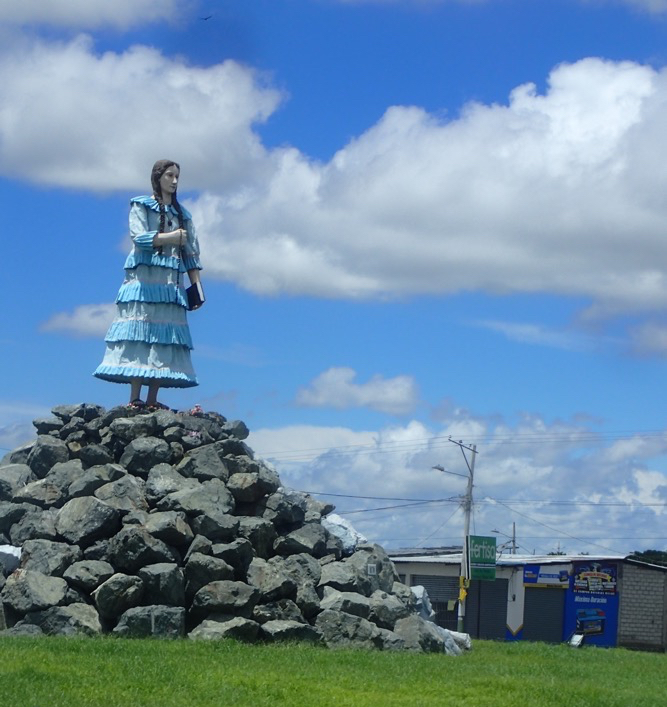


 Puntarenas was discovered by Hernan Ponce de Leon in 1519 and is located south of Nicaragua and north of Panama… on one side of the country is the Pacific Ocean side and to the other, the Caribbean. The city of Puntarenas is surrounded by lush rainforests full of tropical plants, exotic animals and plenty of outdoor adventure activities. The rainforest here is really quite odd – it is a strange blend of dry forest meeting the edge of typical tropical rainforest, but because we are here in the middle of the dry season, everything has a thick layer of dust over it… it was very unusual to see rainforest looking like a tinderbox and covered in dust.
Puntarenas was discovered by Hernan Ponce de Leon in 1519 and is located south of Nicaragua and north of Panama… on one side of the country is the Pacific Ocean side and to the other, the Caribbean. The city of Puntarenas is surrounded by lush rainforests full of tropical plants, exotic animals and plenty of outdoor adventure activities. The rainforest here is really quite odd – it is a strange blend of dry forest meeting the edge of typical tropical rainforest, but because we are here in the middle of the dry season, everything has a thick layer of dust over it… it was very unusual to see rainforest looking like a tinderbox and covered in dust.


 Costa Rica is very famous for its lush tropical fruit exports, and we made a quick stop at a fruit stall to sample all the beautiful fruits and to stock up on lovely cold fruit smoothies. The mango was absolutely delicious! So many beautiful fresh fruits, I can imagine if you came down here on holiday from somewhere like Michigan or something, you’d think it was paradise.
Costa Rica is very famous for its lush tropical fruit exports, and we made a quick stop at a fruit stall to sample all the beautiful fruits and to stock up on lovely cold fruit smoothies. The mango was absolutely delicious! So many beautiful fresh fruits, I can imagine if you came down here on holiday from somewhere like Michigan or something, you’d think it was paradise.

 Also for the tourists to try, was some freshly squeezed sugar cane juice, and they demonstrated for us how it was traditionally extracted from the cane. It was very sweet and brought back memories of chewing and sucking on raw sugar cane up in Hervey Bay when i was a kid.
Also for the tourists to try, was some freshly squeezed sugar cane juice, and they demonstrated for us how it was traditionally extracted from the cane. It was very sweet and brought back memories of chewing and sucking on raw sugar cane up in Hervey Bay when i was a kid. We stopped also at a cashew orchard, and while all of us knew that cashews were a tree nut, none of us had ever seen a cashew tree before… the cashews comes from this enormous fruit, most of which is barely edible and part of which is actually toxic. And seeing this, and seeing how much is wastage, I now understand why cashews are so expensive.
We stopped also at a cashew orchard, and while all of us knew that cashews were a tree nut, none of us had ever seen a cashew tree before… the cashews comes from this enormous fruit, most of which is barely edible and part of which is actually toxic. And seeing this, and seeing how much is wastage, I now understand why cashews are so expensive.



 This fellow was named ScarFace – I couldn’t quite make out the reason for his name sake, I was too distracted by Ruiz our boat driver climbing out into the water to hand feed the bloody big thing with a piece of chicken! ScarFace must have been close to 4m long and probably a few hundred kilos, and I’m pretty sure he could make short work of Ruiz if he decided to…
This fellow was named ScarFace – I couldn’t quite make out the reason for his name sake, I was too distracted by Ruiz our boat driver climbing out into the water to hand feed the bloody big thing with a piece of chicken! ScarFace must have been close to 4m long and probably a few hundred kilos, and I’m pretty sure he could make short work of Ruiz if he decided to…
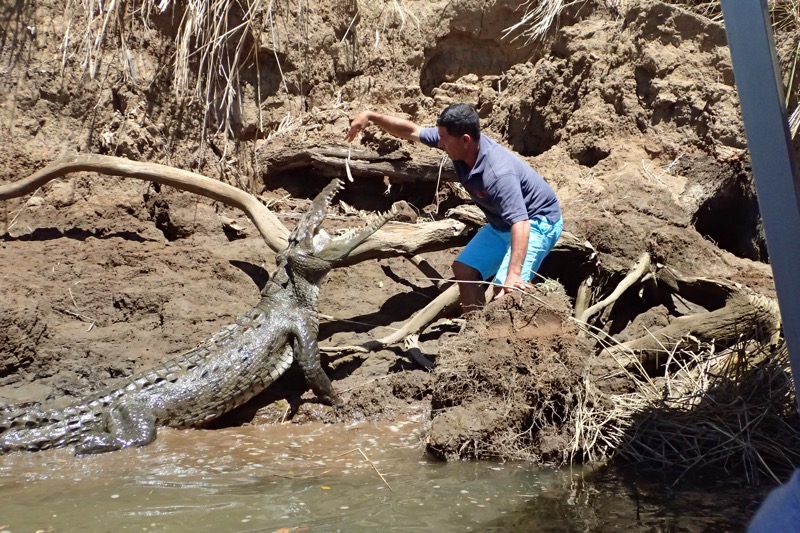 There is something very sly looking about crocodiles when they are just still and watching you… :/
There is something very sly looking about crocodiles when they are just still and watching you… :/  This big one was closer to 5m long, and nicknamed Tornado ever since he was seen death rolling a COW that had come down the bank to drink from the river. A COW!
This big one was closer to 5m long, and nicknamed Tornado ever since he was seen death rolling a COW that had come down the bank to drink from the river. A COW!  Grey-blue great heron… very pretty, and presumably very fast if they can survive here with their snappy aquatic neighbours.
Grey-blue great heron… very pretty, and presumably very fast if they can survive here with their snappy aquatic neighbours.
 Quaint little restaurant at the top of the mountain – the Waterfall of Love, which sounded like a tacky carnival ride, but was closed so I couldn’t go and see what I was certain was going to be very interesting decor!
Quaint little restaurant at the top of the mountain – the Waterfall of Love, which sounded like a tacky carnival ride, but was closed so I couldn’t go and see what I was certain was going to be very interesting decor! After this we went to Villa Lapa, which is a resort area that has been built in the style of a traditional Costa Rican village. Andres was very well versed on all the plants, trees, fruits, animals and insects of the region and pointed out 1001 different tropical plants… many of which were very familiar to Australians. We did try to communicate that a lot of the plants he was telling us about in some detail, were growing quite happily in our gardens at home, but alas, he persisted comments like, “My friends, look here, you must see this – it is called a bromeliad/cicada/poinciana.” Le sigh…
After this we went to Villa Lapa, which is a resort area that has been built in the style of a traditional Costa Rican village. Andres was very well versed on all the plants, trees, fruits, animals and insects of the region and pointed out 1001 different tropical plants… many of which were very familiar to Australians. We did try to communicate that a lot of the plants he was telling us about in some detail, were growing quite happily in our gardens at home, but alas, he persisted comments like, “My friends, look here, you must see this – it is called a bromeliad/cicada/poinciana.” Le sigh…
 Village entrance.
Village entrance.
 Typical village Catholic church
Typical village Catholic church
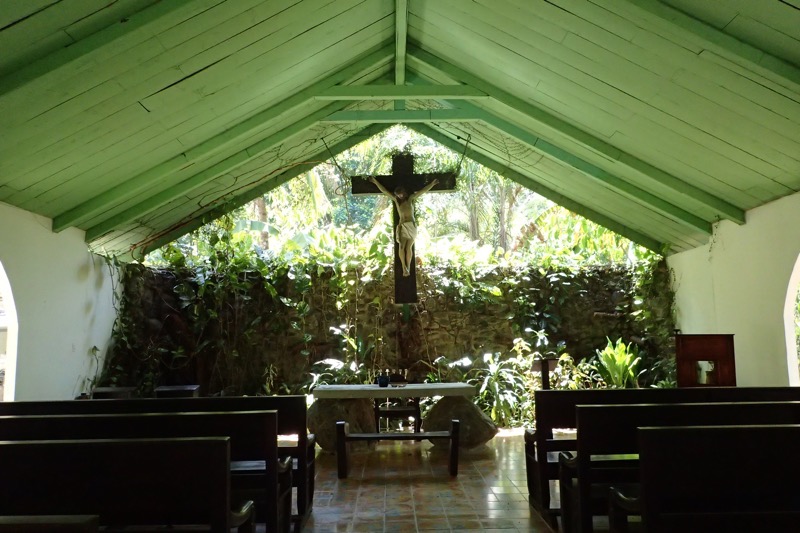 A barn/tavern
A barn/tavern
 After the village we drove to Playa de Leone for some lunch in a very colourful local restaurant with lovely food and cheap ice cold beer… very welcome given it was about 34C and 85% humidity.
After the village we drove to Playa de Leone for some lunch in a very colourful local restaurant with lovely food and cheap ice cold beer… very welcome given it was about 34C and 85% humidity.
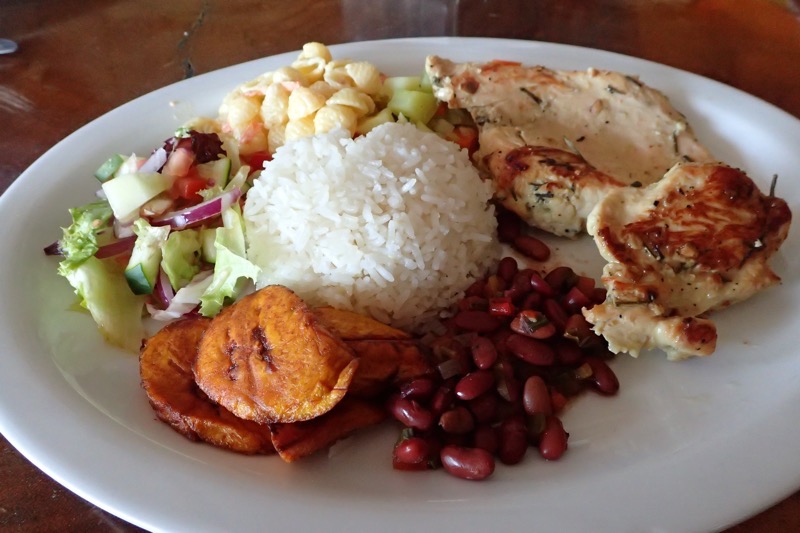
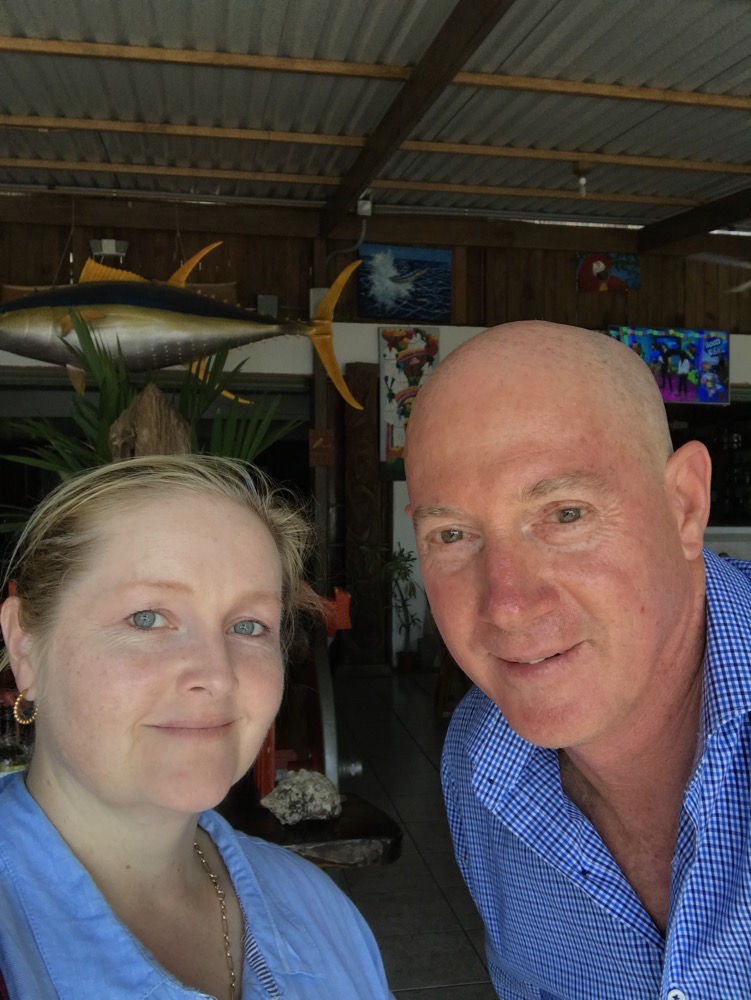 I found myself having lunch with this guy – who I had seen around the ship quite a bit and who looked very familiar. I assumed (incorrectly) that he looked familiar because we had been on tour together at some point… but after barely two minutes conversation over lunch, he said he too thought I was familiar and it turns out we both belong to the SSAA at Belmont and have both been volunteering there for RASA days for the last few years, just in different disciplines! Talk about going half way around the world to meet someone from just around the corner!
I found myself having lunch with this guy – who I had seen around the ship quite a bit and who looked very familiar. I assumed (incorrectly) that he looked familiar because we had been on tour together at some point… but after barely two minutes conversation over lunch, he said he too thought I was familiar and it turns out we both belong to the SSAA at Belmont and have both been volunteering there for RASA days for the last few years, just in different disciplines! Talk about going half way around the world to meet someone from just around the corner!
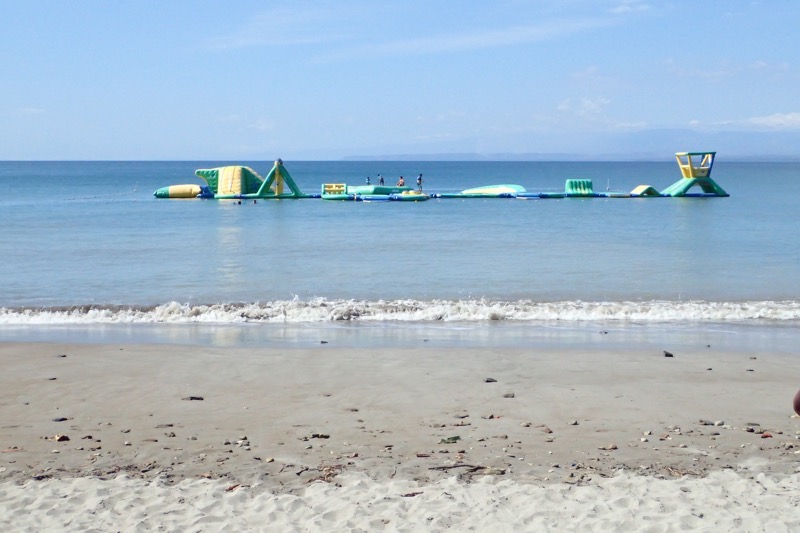
 From here we made our obligatory souvenir shopping stop. Costa Rica has lots of beautiful timber products made from Rosewood, Tigerwood, Purple Heart, Cortex, Fustic, Ironwood, Teak, Lacewood and Guapinol to beautiful effect.
From here we made our obligatory souvenir shopping stop. Costa Rica has lots of beautiful timber products made from Rosewood, Tigerwood, Purple Heart, Cortex, Fustic, Ironwood, Teak, Lacewood and Guapinol to beautiful effect.

 On the way back to the ship, we made another stop to see even more crocodiles at a bridge that has shallow flowing water where the crocodiles like to hang out to stay warm and to catch small fishes in the steam. I counted 25 of these monsters and they were all 4-5m long. It was like the sort of bridge the villains would hang James Bond from and then turn their backs of him and wait for the crocs to get him. We have plenty of big crocs in Australia, but I’ve never seen so many of the large prehistoric beasties in one spot like this.
On the way back to the ship, we made another stop to see even more crocodiles at a bridge that has shallow flowing water where the crocodiles like to hang out to stay warm and to catch small fishes in the steam. I counted 25 of these monsters and they were all 4-5m long. It was like the sort of bridge the villains would hang James Bond from and then turn their backs of him and wait for the crocs to get him. We have plenty of big crocs in Australia, but I’ve never seen so many of the large prehistoric beasties in one spot like this.



 The Panama Canal is a 77 km, manmade, waterway that cuts through the country of Panama connecting the Atlantic Ocean to the Pacific Ocean. The canal is a major international maritime trade route… and on every cruisers check list. We were up early to get a good look at the entry area near the town of Christobel.
The Panama Canal is a 77 km, manmade, waterway that cuts through the country of Panama connecting the Atlantic Ocean to the Pacific Ocean. The canal is a major international maritime trade route… and on every cruisers check list. We were up early to get a good look at the entry area near the town of Christobel. At either end of the canal are major port operations allowing for the offloading of containers to be moved by rail instead of through the lock system. The locks assist ships in being elevated 26 metres above sea level to a large manmade lake, Gatun Lake, and again a second set of locks allow the ships to be moved back down to sea level on the Panama City side. The entire system was devised to allow ships to avoid the hazardous and time consuming Cape Horn route in the southernmost tip of South America via the Straits of Magellan or the Drake Passage – where we were just a few short weeks ago.
At either end of the canal are major port operations allowing for the offloading of containers to be moved by rail instead of through the lock system. The locks assist ships in being elevated 26 metres above sea level to a large manmade lake, Gatun Lake, and again a second set of locks allow the ships to be moved back down to sea level on the Panama City side. The entire system was devised to allow ships to avoid the hazardous and time consuming Cape Horn route in the southernmost tip of South America via the Straits of Magellan or the Drake Passage – where we were just a few short weeks ago. A larger, wider canal was finished in 2016 and it allows for Post-Panamax ships to move through which are capable of carrying more cargo.
A larger, wider canal was finished in 2016 and it allows for Post-Panamax ships to move through which are capable of carrying more cargo. When looking at all these photos of the canal – it is most interesting to note the differing water levels of each lock, that allow the ships to move north and south through the system. The canal was officially opened in 1914 and initially saw about 1,000 ships per year utilising the canal. Most recent numbers see approximately 15,000 ships pass through the canal each year, and a total of 815,000 vessels had used it by 2012.
When looking at all these photos of the canal – it is most interesting to note the differing water levels of each lock, that allow the ships to move north and south through the system. The canal was officially opened in 1914 and initially saw about 1,000 ships per year utilising the canal. Most recent numbers see approximately 15,000 ships pass through the canal each year, and a total of 815,000 vessels had used it by 2012. We were spoon fed a lot of history about the canal across the Panama Isthmus today by our destination expert, Hutch, and while I find this stuff quite interesting – feel free to zone out about now. The first proposals of a canal across Panama date back to 1534 when Charles V of Spain conducted a survey looking for a route that would make the voyage for ships travelling Spain to Peru, shorter and easier thereby giving Spain a significant military advantage over the Portuguese.
We were spoon fed a lot of history about the canal across the Panama Isthmus today by our destination expert, Hutch, and while I find this stuff quite interesting – feel free to zone out about now. The first proposals of a canal across Panama date back to 1534 when Charles V of Spain conducted a survey looking for a route that would make the voyage for ships travelling Spain to Peru, shorter and easier thereby giving Spain a significant military advantage over the Portuguese.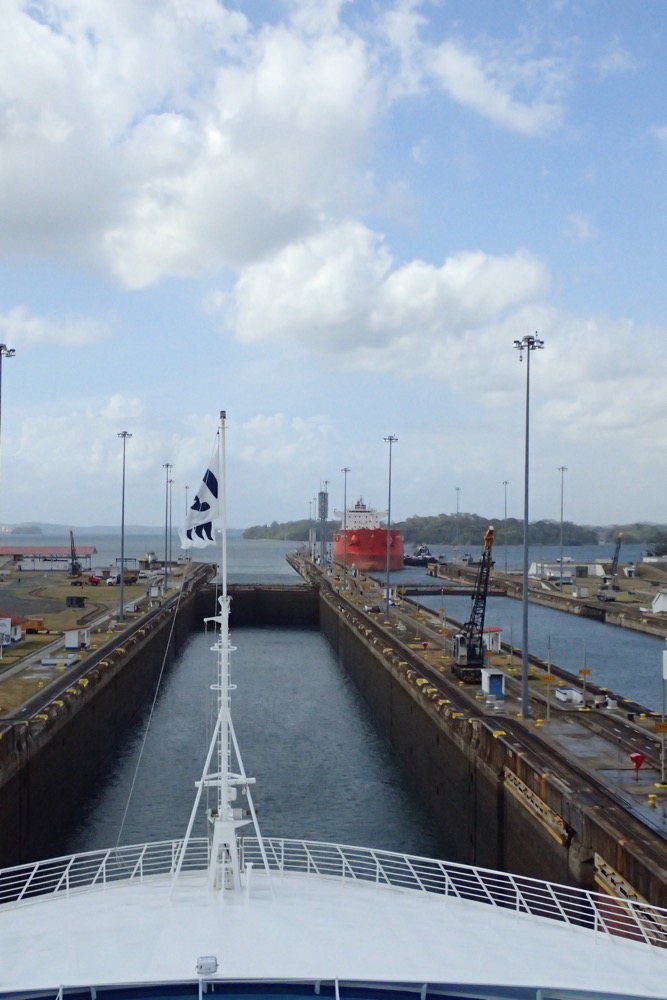 Going through the locks now – you can see what an enormous undertaking it was. It is easily as impressive as seeing the Hoover Dam or the Great Wall of China. The Gatun locks:
Going through the locks now – you can see what an enormous undertaking it was. It is easily as impressive as seeing the Hoover Dam or the Great Wall of China. The Gatun locks:

 Marie, Sandra, Kathleen, and Sandy all dressed up for ‘flashing’ onlookers and the local tug boat captains! 🙂
Marie, Sandra, Kathleen, and Sandy all dressed up for ‘flashing’ onlookers and the local tug boat captains! 🙂  Views of the Gatun Lake…
Views of the Gatun Lake…
 Lunchtime with the Nookies; Terry, Barry, John and Mick (aka Mick The Official, and Original, Bad Influence!)
Lunchtime with the Nookies; Terry, Barry, John and Mick (aka Mick The Official, and Original, Bad Influence!) The Girls taunting the local tug boat captains with their ‘girls’. 😉
The Girls taunting the local tug boat captains with their ‘girls’. 😉 
 One of the tugboats who was following us for quite some time was doing donuts in the water for our amusement and talking to us over their PA system… when we held out beers for them, they said “We wish.” and “Now, you’re just being mean!” as we were partying on the deck and they were stuck working… poor fellas. I think they followed us for an hour hoping someone was going to flash their bits! 🙂
One of the tugboats who was following us for quite some time was doing donuts in the water for our amusement and talking to us over their PA system… when we held out beers for them, they said “We wish.” and “Now, you’re just being mean!” as we were partying on the deck and they were stuck working… poor fellas. I think they followed us for an hour hoping someone was going to flash their bits! 🙂 
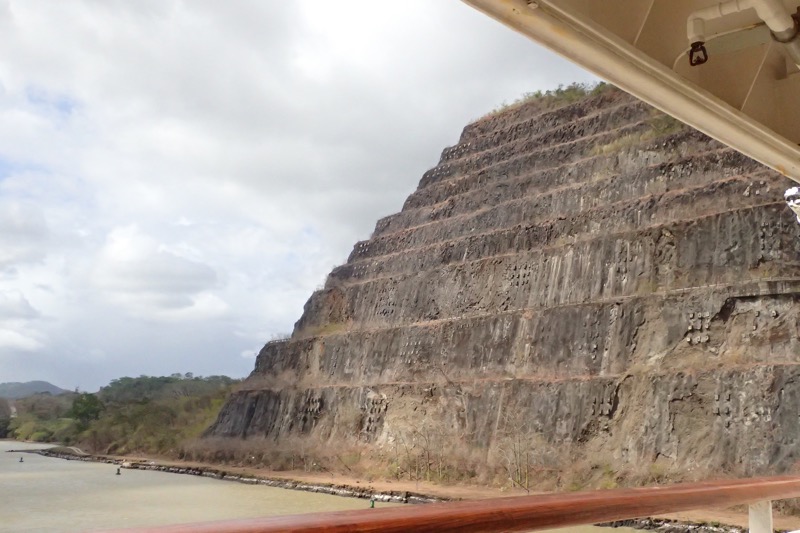
 The Centennial Bridge
The Centennial Bridge 
 Out the other side of Gamboa we found ourselves going through the Pedro Miguel Locks and then the Mira Flores Locks. I was back on the front of the ship on the deck 11 view deck to see this – you can really see the water levels moving up and down to move these enormous ships – our cruise ship and the car carrier that we had been moving neck and neck with all day.
Out the other side of Gamboa we found ourselves going through the Pedro Miguel Locks and then the Mira Flores Locks. I was back on the front of the ship on the deck 11 view deck to see this – you can really see the water levels moving up and down to move these enormous ships – our cruise ship and the car carrier that we had been moving neck and neck with all day. 
 The other interesting thing we learned today was the cost of using the Canal. The tolls are set by the Panama Canal Authority and are based on the type of ship and what type of cargo it may be carrying. For examples, container cargo ships are assessed on a unit of measurement called a ‘twenty-foot equivalent unit’ TEU, which is roughly the size of a regular shipping container. From last year, the toll was about USD$90 per TEU… which doesn’t sound too much until you consider the average Panamax container ship can take over 4000 TEU. Passenger cruise ships are calculated differently – a cruise ship of over 30,000 tonnes is charged based on the number of berths on the ship/the number of passengers that can fit on the ship, not necessarily the number of passengers that are on the ship. The cost per berth as of 2016 is $111 for unoccupied berths (why?) and $138 for occupied berths. Other ships are calculated based on the amount of cubic meters of water they displace which is sounding too much by math for me.
The other interesting thing we learned today was the cost of using the Canal. The tolls are set by the Panama Canal Authority and are based on the type of ship and what type of cargo it may be carrying. For examples, container cargo ships are assessed on a unit of measurement called a ‘twenty-foot equivalent unit’ TEU, which is roughly the size of a regular shipping container. From last year, the toll was about USD$90 per TEU… which doesn’t sound too much until you consider the average Panamax container ship can take over 4000 TEU. Passenger cruise ships are calculated differently – a cruise ship of over 30,000 tonnes is charged based on the number of berths on the ship/the number of passengers that can fit on the ship, not necessarily the number of passengers that are on the ship. The cost per berth as of 2016 is $111 for unoccupied berths (why?) and $138 for occupied berths. Other ships are calculated based on the amount of cubic meters of water they displace which is sounding too much by math for me. The most expensive toll ever paid was by a cruise ship called the Norwegian Pearl which paid over USD$375,000 for an expedited passage – the average cost is about $54,000 for a ship of that size, but they basically paid to jump the queue. There was another ship when work was being carried out on the Gatun Locks, an tanker I think, that once paid about $250,000 to avoid waiting in a 90 ship queue (7 days wait) on what should have been a $13,500 toll.
The most expensive toll ever paid was by a cruise ship called the Norwegian Pearl which paid over USD$375,000 for an expedited passage – the average cost is about $54,000 for a ship of that size, but they basically paid to jump the queue. There was another ship when work was being carried out on the Gatun Locks, an tanker I think, that once paid about $250,000 to avoid waiting in a 90 ship queue (7 days wait) on what should have been a $13,500 toll. In the image below, you can see the water racing through a culvert… this is how the lock system works – by using gravity to move metric shit tonnes of water to allow each ship to raise and lower as required.
In the image below, you can see the water racing through a culvert… this is how the lock system works – by using gravity to move metric shit tonnes of water to allow each ship to raise and lower as required.


 Currently, the canal is handling far more traffic than had ever been projected by the original engineers – it was estimated that it would move about 80 million tonnes of cargo each year, but in 2015, over 340 million tonnes was moved through the canal… I gotta ask myself, how much of the stuff on these container ships is full of shit made in China destined for $2 stores the world over? Are we overdoing this moving crap around the world thing? Something to think about…
Currently, the canal is handling far more traffic than had ever been projected by the original engineers – it was estimated that it would move about 80 million tonnes of cargo each year, but in 2015, over 340 million tonnes was moved through the canal… I gotta ask myself, how much of the stuff on these container ships is full of shit made in China destined for $2 stores the world over? Are we overdoing this moving crap around the world thing? Something to think about… The rolling bumpers that allow the ship to move through the canal without damage – with barely a 1 foot clearance these rollers keep the ship from rubbing along the canal’s concrete edges.
The rolling bumpers that allow the ship to move through the canal without damage – with barely a 1 foot clearance these rollers keep the ship from rubbing along the canal’s concrete edges. In the old days, mules were used to pull ships through the canal – today ‘mules’ are still used to pull the ships through and help keep their sideways movement controlled. Only now they are 50 tonne machines made by (originally General Electric) and Mitsubishi now. Six of these are attached to the ship for the transit, and believe it or not the cables are sent out to the ship at the beginning of any transit by two little guys in a row boat who then pass them to a crew member on the ship who has gone out a watertight door and down a rope ladder to ‘catch’ it! Many different methods of throwing and/or shooting the cables to the ship have been tried in the past, but the little guys in the row boats have proved most effective over time.
In the old days, mules were used to pull ships through the canal – today ‘mules’ are still used to pull the ships through and help keep their sideways movement controlled. Only now they are 50 tonne machines made by (originally General Electric) and Mitsubishi now. Six of these are attached to the ship for the transit, and believe it or not the cables are sent out to the ship at the beginning of any transit by two little guys in a row boat who then pass them to a crew member on the ship who has gone out a watertight door and down a rope ladder to ‘catch’ it! Many different methods of throwing and/or shooting the cables to the ship have been tried in the past, but the little guys in the row boats have proved most effective over time. Mules…
Mules… Heading out the other side you can see the large port infrastructure at the other end of the Panama Railway… large cranes dot the skyline to unload/reload ships that are not traversing through the canal.
Heading out the other side you can see the large port infrastructure at the other end of the Panama Railway… large cranes dot the skyline to unload/reload ships that are not traversing through the canal. Elaine and Anyse enjoying the view from the Deck 10 forward viewing deck.
Elaine and Anyse enjoying the view from the Deck 10 forward viewing deck. And then, before you know it… ta-da! We are back in the Pacific Ocean, and well, you know – we could swim home from here, right? 😉
And then, before you know it… ta-da! We are back in the Pacific Ocean, and well, you know – we could swim home from here, right? 😉 
 Our first stop in Cartagena today was up the mountain that overlooks the city, to La Popa Monastery. The monastery was built in the 17th century and it continues to houses a community of Augustinian monks today. On the way up the mountain were markers for the traditional Catholic Stations of the Cross, however there are 14 of them, and from my heavily indoctrinated Catholic school recollections there was only ever 12… Mercedes was unable to explain away the extra stations, so I guess that one will remain a mystery.
Our first stop in Cartagena today was up the mountain that overlooks the city, to La Popa Monastery. The monastery was built in the 17th century and it continues to houses a community of Augustinian monks today. On the way up the mountain were markers for the traditional Catholic Stations of the Cross, however there are 14 of them, and from my heavily indoctrinated Catholic school recollections there was only ever 12… Mercedes was unable to explain away the extra stations, so I guess that one will remain a mystery.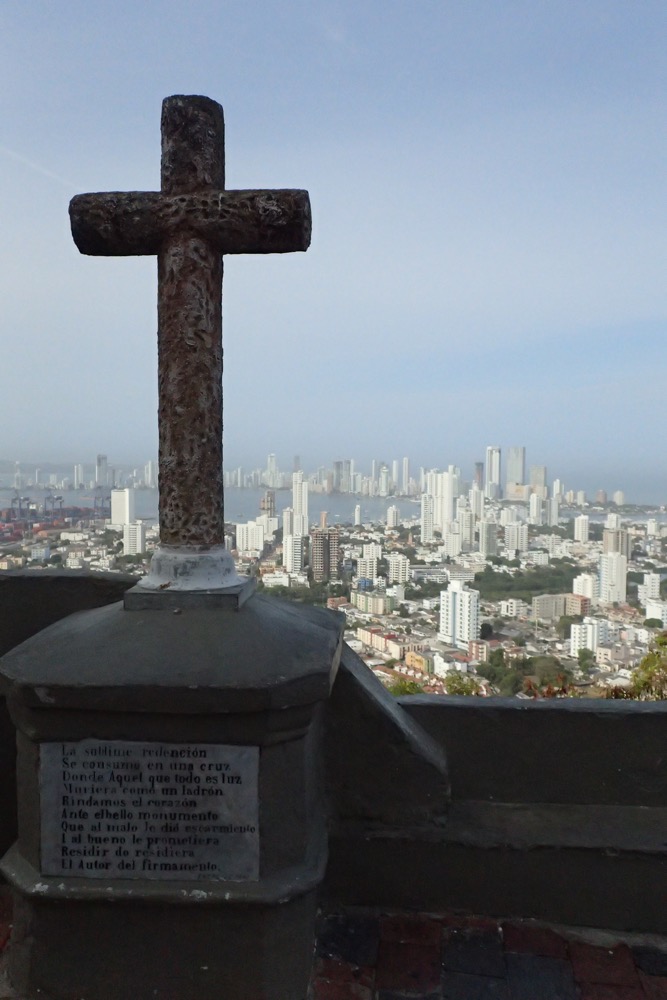 The view over Cartagena.
The view over Cartagena. Steps up to La Popa.
Steps up to La Popa.

 This lovely cloistered courtyard has been cleverly designed to capture rainwater and funnel it to an enormous underground water cistern… the pillars of the courtyard are hollow, and water flows down through the pillars into the cistern for later use, as the subterranean water here is too salty to use for traditional wells.
This lovely cloistered courtyard has been cleverly designed to capture rainwater and funnel it to an enormous underground water cistern… the pillars of the courtyard are hollow, and water flows down through the pillars into the cistern for later use, as the subterranean water here is too salty to use for traditional wells. Every year wealthy local women make the Madonna new clothing and there is a room here dedicated to her old clothes. At first the garments looked very impressive, but on closer inspection, it was evident that most of the embroidery was done by machine so I didn’t even bother taking a photo of any of it. #embroiderysnobs
Every year wealthy local women make the Madonna new clothing and there is a room here dedicated to her old clothes. At first the garments looked very impressive, but on closer inspection, it was evident that most of the embroidery was done by machine so I didn’t even bother taking a photo of any of it. #embroiderysnobs There is a story here that the local pagan Karib and Calamari Indian people worshiped Buziraco, the devil, in the form of a golden goat, and the friar who wanted to build the monastery and the shrine to La Virgen de la Candelaria confronted the devil and his worshippers by throwing the golden goat off the side of the mountain. The devil retaliated with hurricanes and storms until the church was completed, at which point the devil relented and moved deeper into the continent of South America leaving Cartagena alone. The city actually experiences no storms, no earthquakes, and no hurricanes of any sort. This weird diorama at the monastery depicts the native indians worshipping their golden goat… Mercedes, our guide, told us this story was highly unlikely, stating: “Who ever heard of a Catholic priest throwing away gold?”
There is a story here that the local pagan Karib and Calamari Indian people worshiped Buziraco, the devil, in the form of a golden goat, and the friar who wanted to build the monastery and the shrine to La Virgen de la Candelaria confronted the devil and his worshippers by throwing the golden goat off the side of the mountain. The devil retaliated with hurricanes and storms until the church was completed, at which point the devil relented and moved deeper into the continent of South America leaving Cartagena alone. The city actually experiences no storms, no earthquakes, and no hurricanes of any sort. This weird diorama at the monastery depicts the native indians worshipping their golden goat… Mercedes, our guide, told us this story was highly unlikely, stating: “Who ever heard of a Catholic priest throwing away gold?”




 Oh, and nostalgically, I must have seen about 20 old G60 Nissan Patrols today. 🙂 Quite unexpected and not sure why, but they seemed to be everywhere, when you never see them at home anymore. The G60 seems to be an old work horse of choice here and it was lots of fun spotting them in the traffic. BigSal and Trish will recognise them from the air vents under the front windscreen 🙂
Oh, and nostalgically, I must have seen about 20 old G60 Nissan Patrols today. 🙂 Quite unexpected and not sure why, but they seemed to be everywhere, when you never see them at home anymore. The G60 seems to be an old work horse of choice here and it was lots of fun spotting them in the traffic. BigSal and Trish will recognise them from the air vents under the front windscreen 🙂 
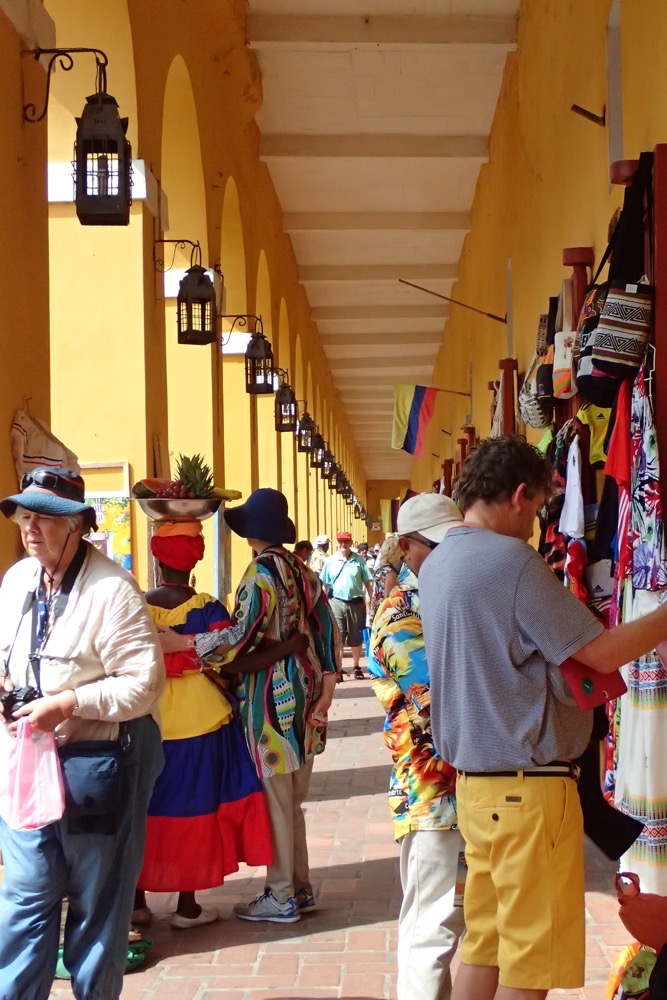 Shopping is a very happy, colourful experience here, excepting where the ladies in the traditional dresses kept coming up to us, and draping their arms around us saying we could take pictures with them and their fruitbaskets for $1. I don’t mind them making money in this way – but please don’t bump into or touch me while I am in a strange country… it makes me immediately do a complete audit of all my pockets and my bag to ensure I still have my wallet and my camera! When playing tourist in a place like Columbia (or Rio or Buenos Aires), you are already on high alert for pickpockets without people touching and bumping into you deliberately. :/
Shopping is a very happy, colourful experience here, excepting where the ladies in the traditional dresses kept coming up to us, and draping their arms around us saying we could take pictures with them and their fruitbaskets for $1. I don’t mind them making money in this way – but please don’t bump into or touch me while I am in a strange country… it makes me immediately do a complete audit of all my pockets and my bag to ensure I still have my wallet and my camera! When playing tourist in a place like Columbia (or Rio or Buenos Aires), you are already on high alert for pickpockets without people touching and bumping into you deliberately. :/ 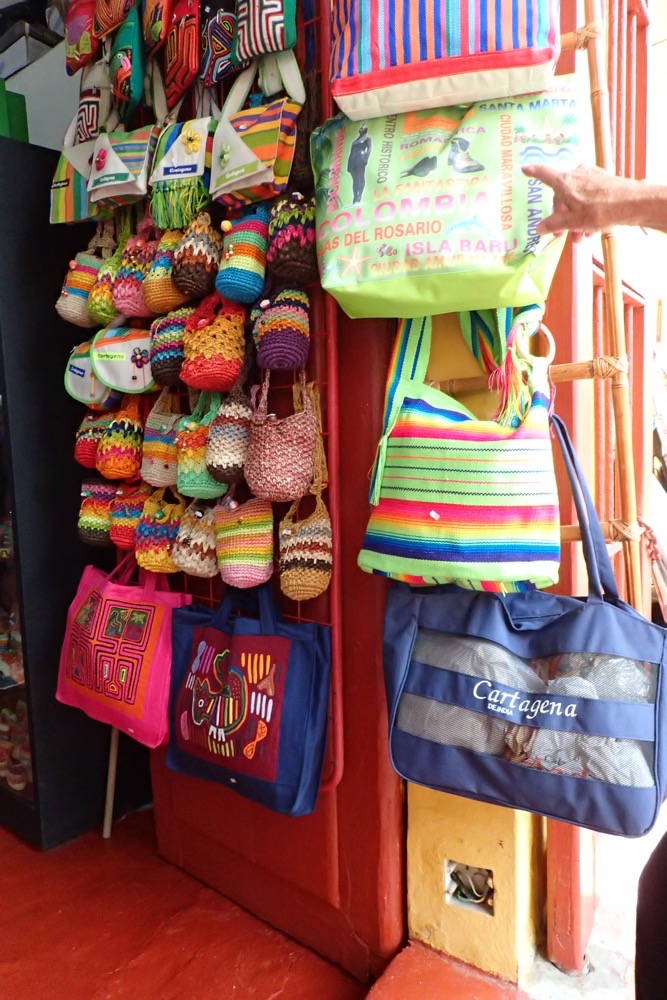 All the souvenirs are crazy colourful.
All the souvenirs are crazy colourful.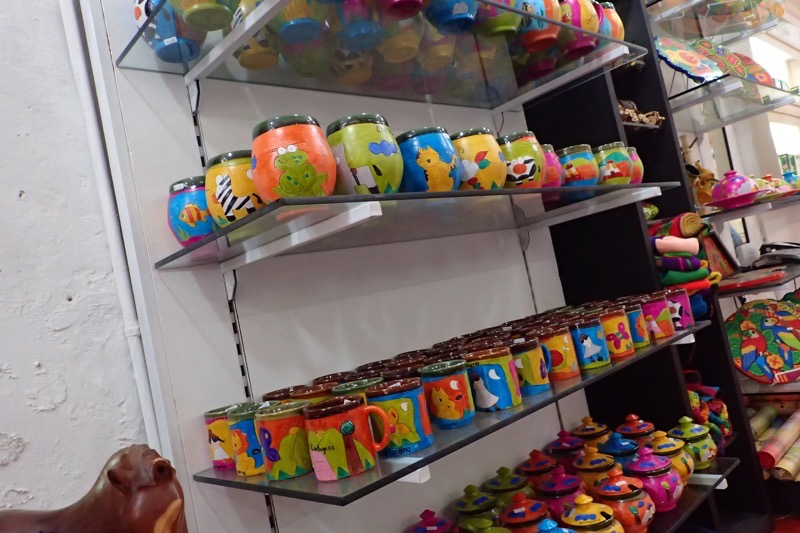

 In the town centre is the Historical Museum of Cartagena, which has an impressive colonial facade from the palace museum. The facade stems from the period of the Spanish Inquisition, which of course, no one expected.
In the town centre is the Historical Museum of Cartagena, which has an impressive colonial facade from the palace museum. The facade stems from the period of the Spanish Inquisition, which of course, no one expected. And the museum itself houses many torture instruments that the inquisition used with great creative effect… we did not have time to go through the museum unfortunately, though I heard from one of my dining companions who did go through the museum, that one was able to have their torture put onto a proxy for the right price. Yes, somehow it was acceptable to the Inquisitors to torture the slave of an intended torturee (for a sturdy donation, of course), and that slave recanting on behalf of his owner was sufficient for these sadistic priests!
And the museum itself houses many torture instruments that the inquisition used with great creative effect… we did not have time to go through the museum unfortunately, though I heard from one of my dining companions who did go through the museum, that one was able to have their torture put onto a proxy for the right price. Yes, somehow it was acceptable to the Inquisitors to torture the slave of an intended torturee (for a sturdy donation, of course), and that slave recanting on behalf of his owner was sufficient for these sadistic priests! The Old City is the walled historic centre of Cartagena, which (like everything else in South America) has been listed as a UNESCO World Heritage Site. It is full of winding streets and bright colourfully painted Spanish colonial architecture. Mercedes informs us here that many of the old private homes are now all used as hotels, bars and restaurants. The homes were built to house large Catholic merchant families where it was not uncommon to have 10-15 children. The downstairs of the house would be for work, trading, selling etc., the mezzanine floor would be used to house guests – as it took 55 days to sail from Spain to Cartagena, people would come and visit for extended periods of time, so most wealthy homes had space for semi-permanent guests. The upstairs of the house would accommodate the actual family, so big enough for 10-15 people. You can see the small balconies of the mezzanine ‘guest’ floors, under the main balconies upstairs for the family.
The Old City is the walled historic centre of Cartagena, which (like everything else in South America) has been listed as a UNESCO World Heritage Site. It is full of winding streets and bright colourfully painted Spanish colonial architecture. Mercedes informs us here that many of the old private homes are now all used as hotels, bars and restaurants. The homes were built to house large Catholic merchant families where it was not uncommon to have 10-15 children. The downstairs of the house would be for work, trading, selling etc., the mezzanine floor would be used to house guests – as it took 55 days to sail from Spain to Cartagena, people would come and visit for extended periods of time, so most wealthy homes had space for semi-permanent guests. The upstairs of the house would accommodate the actual family, so big enough for 10-15 people. You can see the small balconies of the mezzanine ‘guest’ floors, under the main balconies upstairs for the family.
 Many of these old buildings have these mezzanine balconies, original slate and stone floors, and original brickwork from the 16th – 17thC. Absolutely beautiful.
Many of these old buildings have these mezzanine balconies, original slate and stone floors, and original brickwork from the 16th – 17thC. Absolutely beautiful.


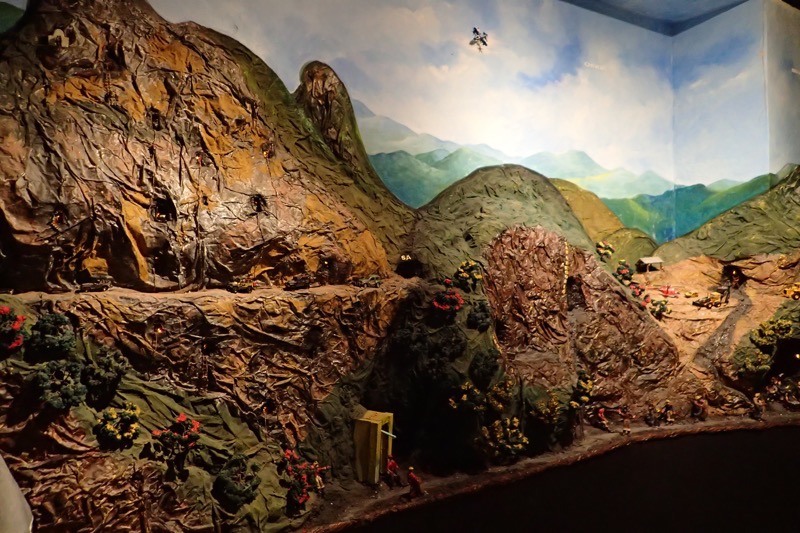
 A diorama depicting the El Dorado Ceremony – “When the Muisca chief passed away, his nephew was acknowledged as the new chief by this people. During a ceremony priests undressed the chief and anointed him with a viscous mixture of soil and gold powder. Then the chief would get on a raft with large amounts of gold and emeralds at his feet. Other chiefs decked with feathers, crowns, armlets, pendants etc carried an offering and sat on the raft. As soon as the raft left the edge of the water, whistles, trumpets flutes and songs would play until the raft reached the centre of the lake. The chief would throw himself into the water with his offerings and the rafter would go back to honour the new heir who was now recognised as the chief and prince.” Not sure what is happening there? Does the nephew get sacrificed for the actual son of the chief to take his place?
A diorama depicting the El Dorado Ceremony – “When the Muisca chief passed away, his nephew was acknowledged as the new chief by this people. During a ceremony priests undressed the chief and anointed him with a viscous mixture of soil and gold powder. Then the chief would get on a raft with large amounts of gold and emeralds at his feet. Other chiefs decked with feathers, crowns, armlets, pendants etc carried an offering and sat on the raft. As soon as the raft left the edge of the water, whistles, trumpets flutes and songs would play until the raft reached the centre of the lake. The chief would throw himself into the water with his offerings and the rafter would go back to honour the new heir who was now recognised as the chief and prince.” Not sure what is happening there? Does the nephew get sacrificed for the actual son of the chief to take his place? The ‘museum’ continued in an equally confusing theme full of strange little dioramas…
The ‘museum’ continued in an equally confusing theme full of strange little dioramas…
 Everywhere were signs and things telling you how superior the Columbia emeralds are to those mined in other areas of the world…
Everywhere were signs and things telling you how superior the Columbia emeralds are to those mined in other areas of the world…
 There was even a guy here hand cutting emeralds…
There was even a guy here hand cutting emeralds… 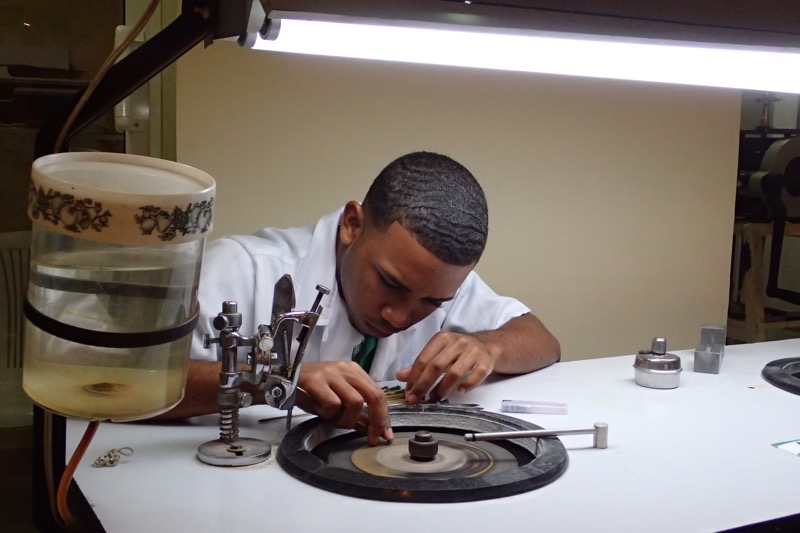


 But ever being a contrary little thing – I hate coffee and don’t really like chocolate either. So I went for a wander in the streets instead of being assaulted by the coffee smells. There are lots of people selling colourful wares along the streets in the Old City. Mostly hats, coral necklaces, bags, textiles, and little wristbands that say ‘Cartagena’ seemed to be really popular – but everything is crazy colourful still.
But ever being a contrary little thing – I hate coffee and don’t really like chocolate either. So I went for a wander in the streets instead of being assaulted by the coffee smells. There are lots of people selling colourful wares along the streets in the Old City. Mostly hats, coral necklaces, bags, textiles, and little wristbands that say ‘Cartagena’ seemed to be really popular – but everything is crazy colourful still.
 Columbia is one of the few South American countries never to be under dictatorial rule, this is in part due to the fact that members of the military are unable to vote – as we know, most dictators emerge from military coups. Military service is mandatory for 18 months for every male at 18 years of age. The only exception is where a family has a singular male child – obviously this is because if anything were to happen to that male child, there would be no ‘man in the house’ to look after the remaining family. (insert a dry futile nod to the blatant thriving patriarchy, here)
Columbia is one of the few South American countries never to be under dictatorial rule, this is in part due to the fact that members of the military are unable to vote – as we know, most dictators emerge from military coups. Military service is mandatory for 18 months for every male at 18 years of age. The only exception is where a family has a singular male child – obviously this is because if anything were to happen to that male child, there would be no ‘man in the house’ to look after the remaining family. (insert a dry futile nod to the blatant thriving patriarchy, here)



 Our next visit was to the Monasterio de San Pedro Cláver, a Jesuit temple that is part of a large monastery with religious buildings that include the Cloister of San Pedro Cláver and a small archaeological museum. It was built between 1580 and 1654, and apparently the body of Saint Peter Claver is located in its main altar.
Our next visit was to the Monasterio de San Pedro Cláver, a Jesuit temple that is part of a large monastery with religious buildings that include the Cloister of San Pedro Cláver and a small archaeological museum. It was built between 1580 and 1654, and apparently the body of Saint Peter Claver is located in its main altar.
 Directly in front of the church is the bronze sculpture Mujer Reclinada, (RecliningWoman) by an artist named Botero. He copped a lot of criticism for placing a naked woman directly outside the Monasterio de San Pedro Cláver, with people saying it was inappropriate for a statue of this type to be placed beside a church – his response? Have you been to the Vatican? It is covered in naked people. Touche Signor Botero.
Directly in front of the church is the bronze sculpture Mujer Reclinada, (RecliningWoman) by an artist named Botero. He copped a lot of criticism for placing a naked woman directly outside the Monasterio de San Pedro Cláver, with people saying it was inappropriate for a statue of this type to be placed beside a church – his response? Have you been to the Vatican? It is covered in naked people. Touche Signor Botero. Buy your own Mujer Reclinada…
Buy your own Mujer Reclinada…
 Inside is another cloistered courtyard which is also home to an active monastery community.
Inside is another cloistered courtyard which is also home to an active monastery community. Many of these items in the Collection of Religious Art were created form the 16th to 20th centuries, being sacradotal in origin, many of the artists names were lost. These items have been either donated to the Jesuits or rescued by them when buildings were being destroyed for redevelopment.
Many of these items in the Collection of Religious Art were created form the 16th to 20th centuries, being sacradotal in origin, many of the artists names were lost. These items have been either donated to the Jesuits or rescued by them when buildings were being destroyed for redevelopment.  This altar is an example of what a modest chapel may contain – as compared to the impressive gold worked altar at La Popa. You can see a Freemason influence with the all seeing eye of God at the very top of the altar.
This altar is an example of what a modest chapel may contain – as compared to the impressive gold worked altar at La Popa. You can see a Freemason influence with the all seeing eye of God at the very top of the altar. The ceiling at Monasterio de San Pedro Cláver.
The ceiling at Monasterio de San Pedro Cláver. And the nave that contains the remains of San Pedro Cláver.
And the nave that contains the remains of San Pedro Cláver.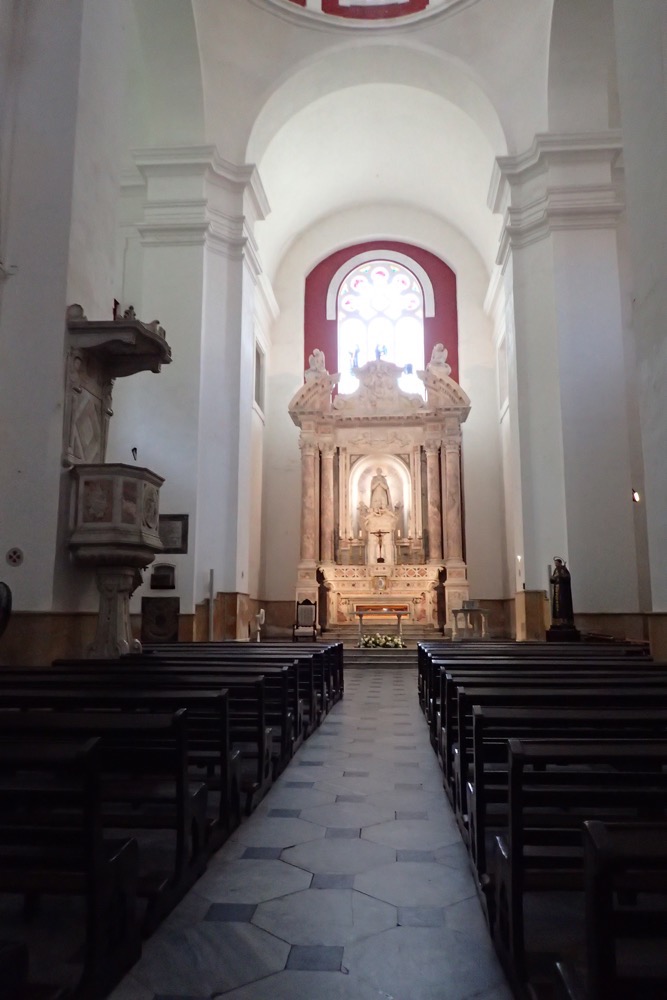 In the courtyard was some domestic macaws clambering all over the tourists. I have to say with those large talons and pointy looking beaks, I only held them momentarily and it was with some trepidation! I don’t trust birds. 😛
In the courtyard was some domestic macaws clambering all over the tourists. I have to say with those large talons and pointy looking beaks, I only held them momentarily and it was with some trepidation! I don’t trust birds. 😛 










